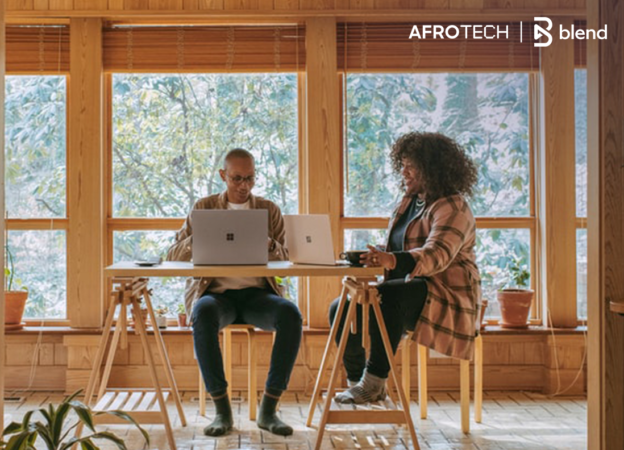On a mission to bring “simplicity and transparency to consumer banking,” digital platform Blend has become a force in the industry by making it easier to access mortgages and other financial products through the power of upgrading technology at banks and other lenders.
For Blend, this mission has meant taking a hard look in the mirror at an industry with a history of creating roadblocks for Black and brown people trying to get ahead financially. As a result, Blend has doubled down and taken up the challenge of addressing financial hurdles from the growing wealth gap to inequalities in homeownership.
Launching an ambitious, multi-pronged approach, Blend has invested in partnerships with those serving minority-owned institutions, while also advocating for policy changes to directly address discriminatory lending practices within underserved communities.
Through The Benchmark, a video series that highlights advice and insight from leaders in various industries, Blend CEO Nima Ghamsari had a conversation with Antoine Thompson, Executive Director of National Association of Real Estate Brokers (NAREB) — the largest and oldest organization for Black real estate professionals. Ghamsari and Thompson get real about the state of homeownership in the Black community and ways to combat hurdles.
With an ownership gap of 30%, Blend uses the conversation to examine solutions, common myths about becoming financially ready and more.
“There are 2.5 to 3 million African Americans who are mortgage ready in this country. They have low debt-to-income ratios, they’ve got a good job, they can pay a mortgage. We have to educate people about the benefits of homeownership, how it strengthens families, how it builds wealth,” Thompson explains.
Breaking it down further, he points out that many would-be homeowners simply lack the opportunities. “Today, there is a Black homeownership rate in the United States of 47% and a white homeownership rate of 75%. Until that gap is eliminated, we’ll keep pressing on.”
Let’s be real. Many Black Americans want to own their own homes, but thanks to a history of redlining — a practice that leads to a lack of access to funding or outright denial — it’s a portion of the American dream that’s been withheld from these individuals. While legislation like the 1986 Fair Housing Act was created to prevent housing discrimination on the basis of race, religion, national origin, sex (and the amended) handicap or family status, lenders and other financial institutions have still managed to find ways to fly under the radar. This is why the numbers often show a different story.
As CNBC reported last fall, “For refinances specifically, Black borrowers are denied mortgage refinance loans, on average, 30.22% of the time, far higher than the overall denial rate of 17.07%.”
These are reasons why Blend continues to push for innovative ways to address bias through technology, better lending practices and other strategies. Through technology, homeownership opportunities for minority groups are starting to become more available — all the more reason to tap in and leverage such efforts.
Closing the Black Homeownership Gap
Addressing Historical Wrongs
Bias and systemic racism have wreaked havoc on everything from America’s education system to its housing programs. In terms of homeownership, it’s resulted in lost opportunities that have helped push the income gap even wider.
Following World War II, for example, Black soldiers returned from a hard-fought war only to face more racism in the form of being denied the right to access portions of the newly created GI Bill, which of course provided white veterans with everything from education funding to “no money down” mortgage opportunities. As a result, Black homeownership has historically struggled as the community fought to move past stifling, Jim Crow-era legislation.
“Unfortunately that program was not available to African Americans that served in WWII. So when we started [NAREB], we came out with a model of democracy in housing. Since that point we’ve worked to create a number of historical wrongs for 73 years in the real estate industry,” says Thompson.
Using Legislation to Move the Needle Forward
COVID-19 has created another set of hurdles for prospective (and current) Black homeowners. Black professionals have lost their jobs at a higher rate than their white peers, making it nearly impossible to begin the buying process for those just struggling to pay rent.
For others, the pandemic has made it harder to refinance or even pushed the very thought of homeownership so far back that many have given up. To move forward, more legislation like the CARES Act is needed to address refinancing and other financial challenges.
Other legislation that may make the industry more competitive includes bipartisan efforts like the “American Dream Down Payment Act,” which would give first-time homebuyers a savings account that includes a tax break as they work to save their down payment.
It’s a bill co-sponsored by former Alabama Sen. Doug Jones, who said in a statement, “Down payments are the biggest barrier to homeownership for first-time homebuyers, especially among low-income and minority Americans, and make it harder to build generational wealth that is often tied to homeownership.”
Expanding Access Through Technology
Those who are mortgage ready have to be given the tools and education that empower them to move forward. Through social media and mobile banking apps, there’s a unique opportunity to leverage the rapid evolution of tech to share information and success stories of people who have gotten it done in order to inspire others.
This includes using tech to combat persisting myths about homeownership, including the idea that you can only purchase a home with a credit score of 850 or with a 20% down payment. “If you’re young or from a community where you’re not a second-, third- or first-generation homeowner, then where do you get that information from?” Thompson asks.
“If they don’t know that they can take advantage of the system in a good way, they won’t,” Blend CEO Ghamsari adds.
Understanding its own presence in the industry, Blend uses technology to address obstacles and gaps in the loan verification process. By facilitating communication between clients and loan teams, Blend automates many steps in the application process that can often lead to bias, consumer frustration and even drop-off in the underwriting process. These solutions create a more level playing field for prospective homeowners.
Fighting the Big Bad Wealth Gap
Closing the wealth gap would be a game changer for the Black community, which has seen a surge of Black entrepreneurs. With 40% of new businesses now being started in their homes, owning one can provide everything from equity to other benefits like providing collateral — things renters are locked out of.
“Real estate represents about 20% of the US economy. When you increase homeownership, you’re helping more folks, from the landscaper to the mover, so there’s a lot that goes on in real estate,” Thompson says. “That’s why increasing homeownership is so important — the impact that it has on the economy.
—
Following racial and other turmoil in the country, Thompson argues that, with so many eyes on these issues, now is the time to create significant change. “I think, at this moment, people want to see action and they want to see leadership.”
Learn more about Blend and how it’s taking the reins in both areas here.


